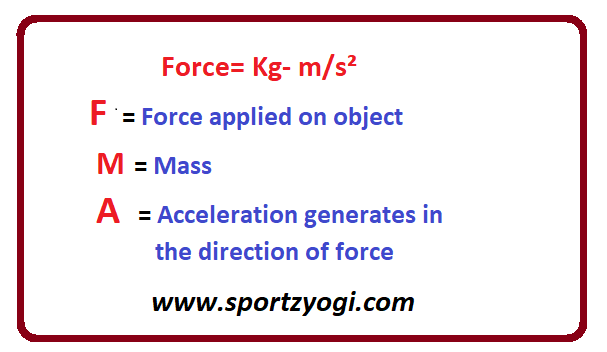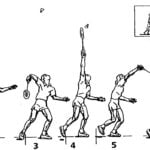CONCEPT OF FORCE IN KINESIOLOGY
Concept of force in kinesiology- Force is the effect that one body has on another, in other words, the force can be defined, any influence that can change that state of MOTION of the body. Force is the effort that one body exerts on another. Through force, only motion developed. force and motion are interrelated. For example – A wrestler on the defense is holding his position against his opponent. To do this, he is straining with great effort to offset the equally strong attack of this opponent. Tremendous force is being exerted by each, yet there may be little or no apparent motion.


Nature of force
- Force can produce motion, stop motion, and prevent motion.
- It can increase or decrease the speed; it may bring about a directional change.
- Force may pull or push to cause motion or balance each other so that bodies remain stationary.
So that, force that effect which one body experience over the other as a result of Which motion may be produced or develop a tendency to produce motion
Characteristics of force
- The magnitude of force [size or amount of force ]
- Point of application
- Direction of force
- A change in any one of them alters the nature of motion.
TYPES OF FORCES
1. INTERNAL FORCE – It is generated within the body, like force due to muscle contraction.
2.EXTERNAL FORCE – It is acting out of the body like the gravity of the earth’s effects on the body or any object.
- CENTRIPETAL FORCE – It is a force that is in towards the central axis of the rotating body or an object. According to Newton’s law, acceleration is always produced by a force and that is the direction of acceleration. Therefore, it is clear that the force acts on a point while doing a circular motion, whose direction is always towards the center of the circle. Such a force is called a centripetal force. Without this force, circular motion is impossible. In this way, when an object moves on a radius path from normal speed V to G, acceleration is produced in its speed whose value V² / r remains fixed but the direction changes. If the mass of the object is M, then the value of centripetal force will be-
FORCE = MASS ✕ Acceleration [Velocity ² / radius] - CENTRIFUGAL FORCE – It is a force directed outward away from the central axis of the body or an object. According to Newton’s law of action-reaction, every action of action also has a reaction, which is equal to the action in the result, but opposite in direction. Therefore, when an object rotates in a circular path, the reaction force of the centripetal acting on it is called the centrifugal force. Like when a person sitting in a moving vehicle suddenly turns to the right and collides with a jerk on the left side. FORCE = MV²/r
- GRAVITATIONAL FORCE – We all know that Earth also pulls the object towards its center, that force is called gravitational force, and acceleration generated by this force is called gravitational acceleration. The gravitational force exerted on the object is called weight.
Concept Of Force In Kinesiology
MAGNITUDE OF FORCE
The amount or size of the force that is being applied makes up the magnitude of the force vector. It is the force that gives body weight and it is measured in terms of body weight when you hold a ball in the hand, the pull of gravity is felt like the weight of the ball. The basic unit in the USA system is the pound and in the metric system, it is the newton. The magnitude of muscular force is in direct proportion to the number and size of the fiber in the muscle that is contracting.
Factor affecting the magnitude of the force
- Effect of lever
- The resistance of air and water
- Friction force
FRICTION
FRICTION is the resistance to motion of one object moving relative to another. It is not a fundamental force, like electromagnetic or gravity .instead, scientists believe it is the result of the electromagnetic attraction between charged particles on two touching surfaces.
Causes of friction
The causes of this resistive force are molecular adhesion, surface roughness, and deformations. Adhesion is the molecular force resulting when two materials are brought into close contact with each other.
Friction In Sports
Friction plays a big role in rolling sports such as tenpin bowling and curling in tenpin, the friction resistance on the ball makes it slow down and also enables the spin on the ball to make it roll in an arc. The mass and the surface composition of the ball and the amount of oil on the; will affect the magnitude of the friction between the bowling and bowling lane. The more oil on the lane means the ball is slow down less and the harder it is for the bowler to send the ball in a curved path.
Types of friction
Static friction – Static friction operates between two surfaces that are not moving relative to each other.
Kinetic friction – Kinetic friction acts between objects in motion
In liquid, friction is the resistance between the moving layer of fluid which is also known as viscosity. In general, more viscous fluid is thicker .so honey has more fluid friction than water.
Air Resistance
Air resistance is also a form of friction, as it describes the resistance between the surface of an object or person and the air. air resistance plays a role in many sports in which balls or other objects are thrown and in sports in which the person moves through the air such as running and cycling.
Positive Friction
The friction that helps in moving objects is called positive friction action. For example, in track and field sports, shoes are fitted with sole different types such as rubber or spike. So that to get the force by reacting as much as possible without slipping.
CONCEPT OF FORCE IN KINESIOLOGY
ADVANTAGES OF FRICTION
- It becomes helps to walk on a slippery road due to friction.
- when we move on ice it becomes helps to walk due to friction.
- We can not able to fix a nail in the wall or wood without friction.
- Just because of friction, the object can be placed at the position and shaped.
- The rigid skin of our fingers and our palms enable us to grab and hold objects .like in cricket, the players use grip to hold it.
DISADVANTAGES OF FRICTION
It causes injuries if a player slides across over the ground Excess amount of friction means extra energy, thus energy is being wasted Just because of friction, there are wear and tear of an object.
Read more
https://www.sportzyogi.com/kinesiology-in-sports/





